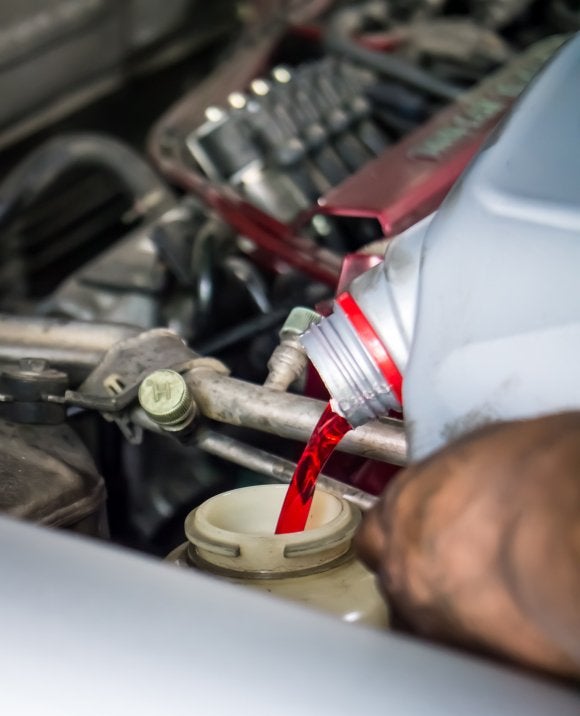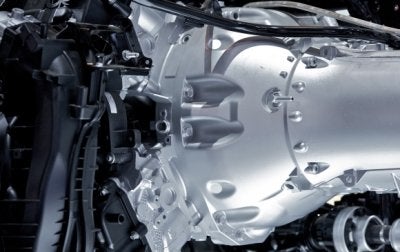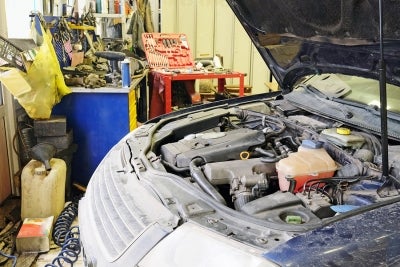-
A Car Owner’s Guide to Selecting Automatic Transmission Fluid
If you take your car to a transmission service shop in Bethesda for routine maintenance, you can leave it up to the professionals to select the best fluid for your automatic transmission. However, if you’re the do-it-yourself type you will need to choose your own transmission fluid when changing out the old fluid. It’s recommended that you leave this maintenance service to the professionals, but if you insist on changing your own transmission fluid make sure you choose the right fluid to prevent damaging your car’s transmission. Here are some important things to know about selecting automatic transmission fluid for your vehicle.

When to Change Transmission Fluid
First and foremost, when talking about transmission fluid it’s important that you know when you need to change the fluid inside your transmission. Generally, transmission fluid should be changed every 24,000 to 36,000 miles, or approximately every two to three years. Refer to your car’s owner’s manual for more specific transmission fluid change interval information related to your make and model. You can also ask your transmission technician for a recommended fluid change interval based on the condition of your transmission.
Automatic Transmission Fluid Types
There are two main types of transmission fluid, Dextron and Mercon. Your owner’s manual will tell you which type of transmission fluid your vehicle uses. You will also need to decide between synthetic and conventional transmission fluid . Synthetic fluid is more expensive than conventional oil, but it performs better at higher temperatures and provides better overall protection. However, if you drive an older vehicle the transmission might not be designed with synthetic fluid in mind.
Transmission Fluid Brands
When it comes to brands, there’s little difference between the major transmission fluid brands. If you want a specific brand recommendation, check with a transmission repair shop in your area or ask for a recommendation at the auto parts store you frequent to purchase fluid.
-
How to Tell When Your Car Needs a Transmission Flush
Generally speaking, it’s a good idea to get a transmission flush every 30,000 miles or every two years, whichever comes first. However, depending on the age and condition of your transmission and other factors such as how you drive and how well you maintain your transmission, there may be times when you need to get a transmission flush sooner. If you recognize any of these common signs, visit a transmission shop in Rockville, and Bethesda for a transmission flush service.

Problems Shifting Gears
Regardless of whether you drive an automatic or manual, problems shifting gears is an indication that the transmission fluid contains too much dirt or sludge which is causing a sluggish response in the gearbox. For automatic transmissions, you may notice that the vehicle changes gears faster or slower than normal. In manual transmission vehicles, you may it very difficult to change the gears at all. In either case, visit a transmission repair shop to find out if a flush is the answer to the problems you are experiencing.
Vehicle Surging
Another tell-tale sign of a transmission in need of a flush and fill is unexplainable surging of the vehicle. Transmission fluid that is very dirty or full of sludge does not allow for adequate flow through the transmission, which can cause the vehicle to surge forward for no good reason. This problem is usually most noticeable when the vehicle slows down and comes to a stop at a light or stop sign.
Dirty or Burnt-Smelling Transmission Fluid
As a part of maintaining your vehicle, get in the habit of inspecting the transmission fluid on a regular basis. If the fluid looks very dirty or smells burnt, visit a transmission repair shop in Silver Spring, MD for a flush service so you can have fresh fluid added for optimal performance, lubrication, and efficiency.
-
What Does the Transmission Do?
Drivers have lots of questions about transmissions, but perhaps the most important one to answer is about how transmissions work. Although you aren’t expected to know the name of every component that makes up the transmission (there are thousands) or the scientific principles that make transmission work, knowing the basics of what your transmission does and how it operates can help you identify when something is wrong and understand the importance of visiting an experienced transmission repair shop in Rockville and Bethesda for all your transmission service needs.

Tra nsmissio n Componen ts
The first step in learning about how transmissions work is to understand the main components inside your transmission. Learning about these components can also help when talking to your transmission repair mechanic about the problems you are experiencing or the services recommended for your transmission. The main components that make up an automatic transmission include:
- Planetary gear sets that provide the various forward and reverse gear ratios
- Hydraulic system which pumps fluid through the valve body to control clutches, bands, and planetary gear sets
- Torque converter which acts like a clutch to allow the vehicle to come to a full stop and stay in gear while the engine is running
- Governors, modulators, or throttle cables that monitor speed and throttle position in order to determine when to shift gears higher or lower
Torque Conversion
Without getting too much into the physics and scientific principles that underlie the workings inside a transmission, the main duty of an automotive transmission is to convert torque created by the engine into forward or reverse acceleration. Transmissions essentially connect the engine to the front or rear wheels so the vehicle will move, and then disconnects when the vehicle is stopped so the engine doesn’t stall. In manual transmissions, this is accomplished by pressing in the clutch.
-
Diagnosing Automatic Transmission Problems
When your car experiences transmission problems, it is important to make an appointment with a transmission specialist right away. While some transmission problems may be minor, other issues could indicate serious troubles in your transmission system. There are several common automatic transmission problems to be on the lookout for. One of the most common issues is a transmission that hesitates to engage when you shift from park to drive. Slow engagement could point to a dirty filter or contaminated transmission fluid. For help diagnosing and repairing your transmission problems, be sure to schedule an appointment with a transmission specialist near Silver Spring, MD. To take a closer look at some of the most common automatic transmission problems , watch this video.
-
How an Automatic Transmission Works
Modern cars and trucks are complex machines, and an automatic transmission may be one of the most intricate components. That’s why it’s important to seek the help of a transmission specialist in Washington DC when you have automatic transmission problems. In order to understand automatic transmissions you must be familiar with their purpose within the vehicle, the parts they utilize, and the problems that they may encounter. Here is a brief overview of how an automatic transmission works.

What It Does
The purpose of a transmission is to connect the engine and the drive wheels in order to deliver the appropriate amount of power based on the activity of the engine. Different combinations of gears alter the distribution of power within the system, affecting the speed and handling of the vehicle. When your vehicle is in neutral, the transmission disconnects the engine and the drive wheels, and the park position involves the locking of the drive wheels so your car or truck stays idle. While manual transmissions make use of a clutch for these purposes, automatic transmissions come in either the front wheel drive or real wheel drive varieties.How It Does It
It may seem like the transmission completes straightforward tasks, but the system requires a great deal of cooperation between different components in order to complete the job. An automatic transmission depends on planetary gear sets to form combinations and ratios that determine how quickly the engine rotates. The torque convertor is relatively analogous to the clutch that would be used in a manual transmission and allows you to stop at red lights and stop signs without turning off your engine.Potential Problems
If you notice strange sounds or oil leaks coming from your car, see a transmission specialist immediately. Your transmission is an integral and complex component of your vehicle, and any problems that are not quickly addressed can lead to more aggravated complications. Transmission problems should always be addressed by a professional auto transmission repair service. -
Spotting Problems with an Automatic Transmission
Automatic transmissions may be easier to maintain and repair than manual transmissions, but that doesn’t mean they aren’t without their own unique set of problems and challenges. Fortunately, automatic transmission problems are relatively easy to spot, which means you can have the problem repaired before your transmission fails completely. Leaky fluid, rough shifts, delayed gear engagement, and dashboard warning lights are some of the most obvious signs of a transmission in need of repair. Watch this video to learn how to spot problems early on with your automatic transmission.
If you suspect your automatic transmission is going out, visit a transmission repair shop in Washington DC as quickly as possible. The sooner your transmission is diagnosed and repair by a professional, the better. Putting off transmission repair will only make the problem worse, and may even lead to more expensive and time-consuming repairs.
-
Tips for Caring for Your Automatic Transmission
The automatic transmission helped revolutionize the automotive industry in the mid-twentieth century. Not only are automatic transmissions much more comfortable and much easier to operate than manuals, but they are also easier to repair and less prone to wear and tear. However, that doesn’t mean automatic transmissions are indestructible. On the contrary, your automatic transmission requires very specific care if you wish to avoid major transmission repair in Washington DC. The following tips should help keep your automatic transmission in great shape and out of the transmission repair shop .

Check Fluid Level and Condition Regularly
Transmission fluid is the lifeblood of your automatic transmission. To keep your transmission in tip-top shape, check the fluid level and condition on a regular basis. Refer to your owner’s manual to learn whether your car should be in park or neutral, and what temperature the transmission should be. When checking the dipstick, smell the fluid and note if it smells burned or like any other fluid, such as gasoline or motor oil. Wipe the fluid off onto a piece of white paper or cloth and check the color against a fresh fluid sample. If the fluid looks very dirty, visit a transmission repair shop in your area for a flush and refill. Changing transmission fluid is not as simple as changing engine oil and should be handled by a transmission service technician.Seek Transmission Repair as Needed
Your transmission will tell you when something is wrong, you just need to learn how to recognize the signs and symptoms of transmission problems. For example, if you notice that the transmission is leaking fluid you should visit a repair shop right away. Also be on the lookout for any unusual noises, smells, or sensations while driving. Loud bangs, grinding noises, the smell of burning metal, rough shifts, delayed shift engagement, and a dashboard warning light are some of the most obvious signs that your transmission may need repair. The longer you put off transmission repair in Washington DC, the bigger the problem will get and the more expensive it will be to repair. -
Transmission Parts: The Torque Converter

Any automatic transmission service in the D.C. metro area will tell you how important the torque converter is for your automatic vehicle’s transmission. This converter replaces the clutch used in a manual transmission and allows the engine to effectively communicate with the wheels. Keep reading to learn about the torque converter and the role it plays in your automatic vehicle.
The torque converter affects the amount of torque that is transferred from the engine to the wheels at any given time; a functioning torque converter allows you to keep the car still while idling by resting your foot on the brake pedal. When you are stepping on the gas, however, a greater amount of torque is being sent from the engine to the wheels, so stopping the car requires a greater exertion of force on the brake pedal. Transmission issues that stem from the torque converter may affect your fuel economy as well as cause overheating and transmission slipping. These issues can be very problematic and may warrant a visit to the transmission repair shop.
Your vehicle’s torque converter is responsible for transferring the proper amount of torque to the wheels from the engine. Any transmission repairs that are needed should be done at a transmission shop.
-
Examining the Most Common Causes of Automatic Transmission Problems
 Automatic transmissions offer fantastic convenience for the driver. If you drive a car with an automatic transmission, it is highly important to keep your transmission system in good repair. By learning about the most common causes of automatic transmission problems, you will be able to schedule transmission service before serious damage has occurred. A transmission specialist at an auto transmission repair in the D.C. Metro Area can help you keep your car’s automatic transmission in peak working shape. Whether you need a minor repair or a full transmission replacement, your transmission shop will provide you with quality services. Read on for more information about the common causes of automatic transmission problems.
Automatic transmissions offer fantastic convenience for the driver. If you drive a car with an automatic transmission, it is highly important to keep your transmission system in good repair. By learning about the most common causes of automatic transmission problems, you will be able to schedule transmission service before serious damage has occurred. A transmission specialist at an auto transmission repair in the D.C. Metro Area can help you keep your car’s automatic transmission in peak working shape. Whether you need a minor repair or a full transmission replacement, your transmission shop will provide you with quality services. Read on for more information about the common causes of automatic transmission problems.Low Fluid
Low fluid is a common culprit for transmission problems . If your automatic transmission is suffering from a fluid leak, this repair issue could cause serious damage to your entire system. Transmission fluid leaks can be caused by loose seals or damaged gaskets. When your fluid is leaking, you may notice bright red liquid pooling up underneath your car.
Worn Torque Converter
Your torque converter is designed to allow the gears of your transmission to spin when your vehicle comes to a stop. Oftentimes, a worn torque converter is the source of automatic transmission problems. When your torque converter is having issues, you may hear strange grinding sounds when you are driving your vehicle. Your transmission repair technician will be able to repair or replace this essential transmission component.
Damaged Solenoid
The solenoid is responsible for pumping automatic transmission fluid all around your system. Occasionally, low fluid levels or electronic issues can cause damage to your solenoid. When your solenoid becomes damaged, your system will not receive the right amount of fluid. This can cause slipping gears or slow shifting. At the first sign of any problems with your automatic transmission, you should be sure to set up an appointment with your transmission shop.
